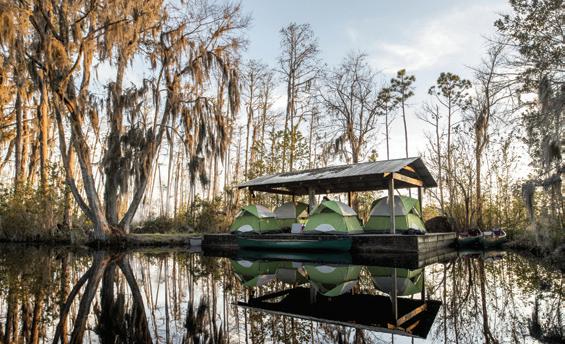
3 minute read
Loggerhead Nest Record
By Rick Lavender Communications and Outreach Specialist GADNR Wildlife Resources Division
Loggerhead sea turtle nesting in Georgia hit a new high this week as the big reptiles beat their modern-day best for most nests on the state’s beaches.
Advertisement
With nesting slowing and hatching surging, the nest count reached 3,953 on July 31 and crawled past 3,960 on August 3, according to the DNR. At press time, the Loggerhead nest count is nearing 4,000 and is expected to top that!
That eclipses the 3,950 nests in 2019, the previous record since comprehensive surveys began along the Georgia coast in 1989. The state’s primary nesting sea turtle hit a low of 358 nests in 2004.
Georgia Sea Turtle Program Coordinator Mark Dodd welcomed news of the record total but cautioned that loggerheads remain on a long, if promising, path to recovery.
“Loggerheads are a long-lived species that don’t reproduce until 30-35 years of age,” said Dodd, a senior wildlife biologist with DNR’s Wildlife Conservation Section. “Based on current trends, we predict it will take at least another 20 years before we reach our recovery goals.”
The region’s population of loggerheads – listed as threatened under the Endangered Species Act – has been increasing at approximately 4 percent annually since the early 1990s. However, modeling developed by the University of Georgia and the U.S. Geological Survey using nest and genetics data indicates the population will plateau at current levels for about the next 20 years, its progress hobbled by low recruitment during the early 2000s, Dodd explained.
If current protections remain in place at least through that period, the model suggests loggerhead numbers will increase again, possibly reaching levels not seen since the late 1950s.
Weighing 300 pounds or more, female loggerheads crawl ashore on beaches, dig a hole at the base of the dunes and lay their eggs, usually at night, from May into August.
All sea turtle nests, including those of species that seldom nest here such as Kemp’s ridley and green, are marked, protected and monitored by the Georgia Sea Turtle Cooperative. The DNRcoordinated network of federally permitted volunteers, researchers and agency employees patrols beaches daily during nesting season.
The effort not only eases predation and increases the number of young that hatch, the data collected is used to assess loggerhead populations, assess threats and inform management. Cooperators also help with beach management. The program has been in play on Georgia beaches for more than 30 years.
To see current nest information, visit: seaturtle.org/ nestdb/?view=3
A dawn-nesting loggerhead sea turtle on Ossabaw Island. Photo by Caleigh Quick, GADNR
WHAT YOU CAN DO All marine turtles in Georgia are protected by state and federal law. To help conserve these species: • Minimize beachfront lighting during nesting season. Turn off, shield or redirect lights. • When walking the beach at night, don’t use flashlights and flash photography. They can deter turtles from coming ashore to nest or cause them to abort nesting. • If you encounter a sea turtle on the beach – including hatchlings – remain quiet, still and observe them only from a distance. • Leave turtle tracks undisturbed. Researchers use them to identify the species and mark nests for protection. • Properly dispose of your garbage. Turtles may mistake plastic bags, Styrofoam and trash floating in the water as food. Ingested trash can clog intestines, resulting in death. • Protect beach vegetation: It stabilizes sand and the natural coastline. • When boating, stay alert and avoid turtles. Of the 84 sea turtles found dead or hurt in Georgia last year, 45 percent that could be assessed had suffered injuries consistent with being hit by a boat. Boaters who hit a sea turtle are urged to standby and immediately call DNR at 800-2-SAVE-ME (800-2728363). • Also report any dead or injured sea turtles seen at 800-2728363. (If the turtle is tagged, include the tag color and number in the report if possible.)










